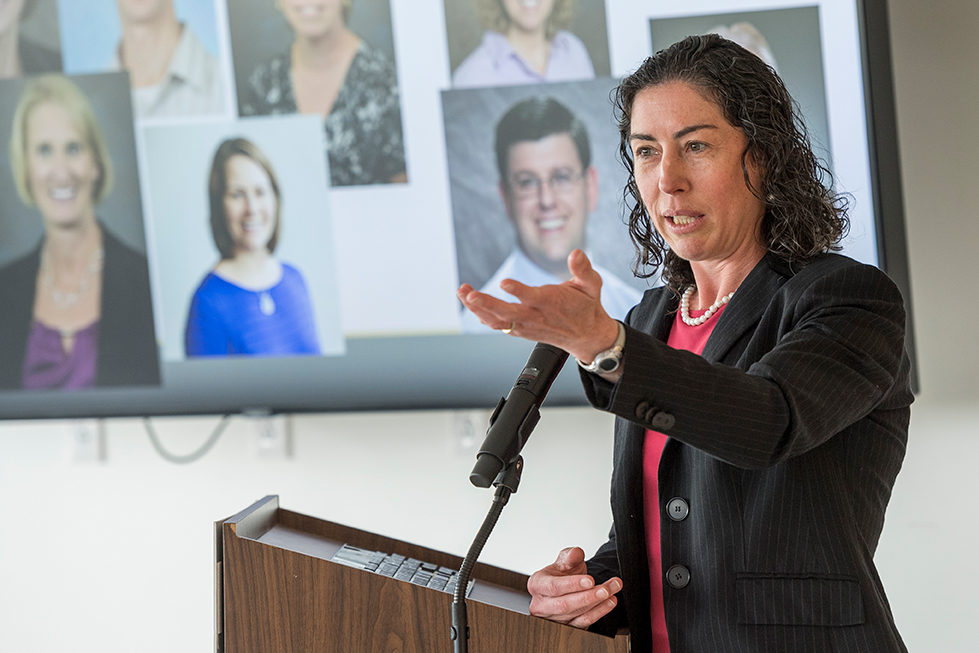Students show how their studies could make people healthier
A University of Delaware graduate student develops pressure-detecting sensors that could help injured patients recover. Another student analyzes brain scans to understand balance in children with cerebral palsy.
These are just two examples of the many students in multiple colleges and departments at the University of Delaware who conduct research with the potential to improve human health. At the University’s 16th annual Biomechanics Research Symposium, held on April 17, 2019 at the STAR Campus, 42 of these stellar students showed off their work.
The Biomechanics Research Symposium was presented by the Center for Biomechanical Engineering Research (CBER), an interdisciplinary research center that develops engineering science and clinical technology to reduce the human impact of diseases such as osteoarthritis, osteoporosis, degenerated discs, and cystic fibrosis.
“Attendees, including the faculty and keynote speaker, were all impressed by the high quality of the student research and presentations,” said X. Lucas Lu, an associate professor of mechanical engineering and chair of the organizing committee for the symposium. “Our students are doing interesting clinical research with a high impact on human health, and they presented their findings well.”

Students show off their research at UD’s Science, Technology and Advanced Research (STAR) Campus.
The symposium’s keynote speaker was Jennifer Stevens-Lapsley, MPT, PhD, a professor and director of the Rehabilitation Science PhD Program in the Physical Therapy Program at the University of Colorado Anschutz Medical Center.
Stevens-Lapsley is focused on identifying, integrating and advancing innovative evidence-based medicine solutions for older adult rehabilitation through highly effective research methods and partnerships. She has almost 20 years of clinical research experience in patients with osteoarthritis planning joint arthroplasty, and more recently, medically complex patient populations. Her research ranges from understanding the mechanisms of skeletal muscle dysfunction to studies of implementation of best rehabilitation practices in post-acute care settings.
Stevens-Lapsley earned her physical therapy degree and doctoral degree in biomechanics and movement science with a focus in applied physiology at the University of Delaware. She then completed post-doctoral training at the University of Florida.

Ashwini Sansare, a graduate student in biomechanics and movement science, explains her research.
The following student poster presentations and podium presentations earned awards.
Top Podium Presentation Awards:
Sagar Doshi, a doctoral student in mechanical engineering, for “Carbon Nanomaterial-Based Novel Functional Garments for Human Motion Analysis.”
Grace McIlvain, a doctoral student in biomedical engineering, for “Brain Mechanical Properties and Balance Reactions in Children with Cerebral Palsy.”
Kaleb Burch, a doctoral student in mechanical engineering, for “Novel Fabric-Based Force Sensors for Continuous Overground Gait Analysis.”
Rebecca Clements, an undergraduate student in biomedical engineering, for “Correlations Between Mechanical Properties of the Adolescent Brain and Risk-Taking Behaviors.”
Top Poster Presentation Awards:
Dana Matthews, a doctoral student in biomechanics and movement science, for “Sedentary Time Relates to Worsening Knee Cartilage Damage Over Two Years: The MOST Study.”
Hiral Master, a doctoral student in biomechanics and movement science, for “Does Walking at Higher Intensities Increase Or Decrease the Risk of Total Knee Arthroplasty?”
People’s Choice Poster Presentation Award:
Nicole Ray, a doctoral student in mechanical engineering, for “Combined Effects of User-Driven Treadmill Control and Functional Electrical Stimulation for Poststroke Rehabilitation.”

Naoaki Ito, a graduate student in biomechanics and movement science, explains his research.


